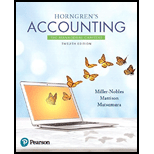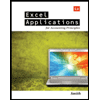
Horngren's Accounting: The Managerial Chapters (12th Edition) (loose Leaf Version)
12th Edition
ISBN: 9780134486826
Author: MILLER-NOBLES, Tracie L.; Mattison, Brenda L.; Matsumura, Ella Mae
Publisher: PEARSON
expand_more
expand_more
format_list_bulleted
Textbook Question
Chapter 4, Problem E4.20E
Preparing financial statements from the completed worksheet.
Learning Objective 1, 2
2. Ending Capital $34,550
Use your answer from Exercise E4−19 to prepare Data Solution’s financial statements.
Requirements
- Complete the income statements for the month ended November 30, 2018.
- Complete the statement of owner’s equality for the month ended November 30, 2018. Assume there were no contributions made by the during the month.
- Complete the classified
balance sheet as of November 30, 2018. Use the report form.
Expert Solution & Answer
Trending nowThis is a popular solution!

Students have asked these similar questions
Can you explain the process for solving this financial accounting problem using valid standards?
general accounting
I am looking for a reliable way to solve this financial accounting problem using accurate principles.
Chapter 4 Solutions
Horngren's Accounting: The Managerial Chapters (12th Edition) (loose Leaf Version)
Ch. 4 - Assets are listed on the balance sheet in the...Ch. 4 - Which of the following accounts would be included...Ch. 4 - Which situation indicates a net loss within the...Ch. 4 - Which of the following accounts is not closed?...Ch. 4 - What do closing entries accomplish? Learning...Ch. 4 - Which of the following is not a closing entry?...Ch. 4 - Which of the following accounts may appear on a...Ch. 4 - 8. Which of the following steps of the accounting...Ch. 4 - Clean Water Softener Systems has Cash of $600,...Ch. 4 - Which of the following statements concerning...
Ch. 4 - What document are financial statements prepared...Ch. 4 - What does the income statement report?Ch. 4 - Prob. 3RQCh. 4 - Prob. 4RQCh. 4 - Why are financial statements prepared in a...Ch. 4 - Prob. 6RQCh. 4 - Prob. 7RQCh. 4 - Prob. 8RQCh. 4 - Prob. 9RQCh. 4 - How could a worksheet help in preparing financial...Ch. 4 - If a business had a net loss for the year, where...Ch. 4 - Prob. 12RQCh. 4 - What are temporary accounts? Are temporary...Ch. 4 - What are permanent accounts? Are permanent...Ch. 4 - How is the Income Summary account used? Is it a...Ch. 4 - Prob. 16RQCh. 4 - If a business had a net loss for the year, what...Ch. 4 - What types of accounts are listed on the...Ch. 4 - Prob. 19RQCh. 4 - What is the current ratio, and how is it...Ch. 4 - Prob. 21ARQCh. 4 - Preparing an income statement Learning Objective 1Ch. 4 - Preparing a statement of owner’s equity. Learning...Ch. 4 - Preparing a balance sheet (unclassified, account...Ch. 4 - Preparing a balance sheet (classified, report...Ch. 4 - Classifying balance sheet accounts Learning...Ch. 4 - Prob. S4.6SECh. 4 - Prob. S4.7SECh. 4 - Determine net loss using a worksheet Learning...Ch. 4 - Identifying temporary and permanent accounts...Ch. 4 - Prob. S4.10SECh. 4 - Posting closing entries directly to Taccounts...Ch. 4 - S412 Identifying accounts included on a...Ch. 4 - Identifying steps in the accounting cycle Learning...Ch. 4 - Calculating the current ratio Learning Objective 6...Ch. 4 - Journalizing reversing entries Learning Objective...Ch. 4 - E416 Preparing the financial statements The...Ch. 4 - Classifying balance sheet accounts Learning...Ch. 4 - Preparing a classified balance sheet and...Ch. 4 - Preparing a worksheet Learning Objective 2: Title...Ch. 4 - Preparing financial statements from the completed...Ch. 4 - Preparing closing entries from an adjusted trial...Ch. 4 - Preparing closing entries from T-accounts Learning...Ch. 4 - Determining the effects of closing entries on the...Ch. 4 - Preparing a worksheet and closing entries Learning...Ch. 4 - Preparing closing entries from an adjusted trial...Ch. 4 - Preparing a worksheet, closing entries, and a...Ch. 4 - Journalizing reversing entries. Learning Objective...Ch. 4 - Journalizing reversing entries Leaning Objectives...Ch. 4 - Preparing financial statements including a...Ch. 4 - Preparing financial statements including a...Ch. 4 - Preparing a worksheet, financial statements, and...Ch. 4 - Completing the accounting cycle from adjusting...Ch. 4 - Completing the accounting cycle from journal...Ch. 4 - Preparing adjusting entries and reversing entries...Ch. 4 - Preparing financial statements including a...Ch. 4 - Preparing financial statements including a...Ch. 4 - Preparing a worksheet financial statements, and...Ch. 4 - Completing the accounting cycle from adjusting...Ch. 4 - Completing the accounting cycle from journal...Ch. 4 - Preparing adjusting entries and reversing entries...Ch. 4 - Using Excel to prepare financial statements,...Ch. 4 - Completing the accounting cycle from adjusted...Ch. 4 - Completing the accounting cycle from adjusted...Ch. 4 - COMPREHENSIVE PROBLEMS Comprehensive Problem 1 for...Ch. 4 - COMPREHENSIVE PROBLEMS Comprehensive Problem 1 for...Ch. 4 - COMPREHENSIVE PROBLEMS Comprehensive Problem 1 for...Ch. 4 - COMPREHENSIVE PROBLEMS Comprehensive Problem 1 for...Ch. 4 - COMPREHENSIVE PROBLEMS Comprehensive Problem 1 for...Ch. 4 - COMPREHENSIVE PROBLEMS Comprehensive Problem 1 for...Ch. 4 - COMPREHENSIVE PROBLEMS Comprehensive Problem 1 for...Ch. 4 - COMPREHENSIVE PROBLEMS Comprehensive Problem 1 for...Ch. 4 - COMPREHENSIVE PROBLEMS Comprehensive Problem 1 for...Ch. 4 - Comprehensive Problem 2 for Chapters 1 —4 This...Ch. 4 - Comprehensive Problem 2 for Chapters 1 —4 This...Ch. 4 - Comprehensive Problem 2 for Chapters 1 4 This...Ch. 4 - Comprehensive Problem 2 for Chapters 1 4 This...Ch. 4 - Comprehensive Problem 2 for Chapters 1 4 This...Ch. 4 - Comprehensive Problem 2 for Chapters 1 4 This...Ch. 4 - Comprehensive Problem 2 for Chapters 1 4 This...Ch. 4 - Comprehensive Problem 2 for Chapters 1 4 This...Ch. 4 - Prob. 4.1TIATCCh. 4 - Prob. 4.1EICh. 4 - Prob. 4.1FSC
Knowledge Booster
Learn more about
Need a deep-dive on the concept behind this application? Look no further. Learn more about this topic, accounting and related others by exploring similar questions and additional content below.Similar questions
- I need assistance with this general accounting question using appropriate principles.arrow_forwardCan you solve this general accounting question with accurate accounting calculations?arrow_forwardBella Brands operates with two divisions, Aftershave and Deodorant. The Aftershave Division produces a chemical that the Deodorant Division also uses. The Aftershave Division also sells this chemical to other firms for $10 per ounce. The cost information for the Aftershave Division is as follows: Variable costs per ounce $ 6.00 Fixed costs per ounce $ 15.00 Monthly production capacity 30,000 ounces If the Aftershave Division is not operating at full capacity and is able to supply the Deodorant Division with its needs for the chemical, what is the minimum transfer price that the Aftershave Division will accept? Multiple Choice None of the choices is correct. $10.00 per ounce $6.00 per ounce $15.00 per ounce $3.00 per ouncearrow_forward
- Brar Incorporated supplied the following financial information for analysis: Depreciable assets (purchased at the beginning of year 1) $ 4,500,000 Profits before depreciation (all in cash flows at end of year): Year 1 960,000 Year 2 1,400,000 Year 3 2,100,000 Replacement cost of depreciable assets at end of: Year 1 $ 5,000,000 Year 2 6,200,000 Year 3 7,600,000 The assets are depreciated at a rate of 12% per year and have no salvage value. What is the ROI for year 2 using historical cost, net book value? Multiple Choice 26.60% 24.72% 25.15% 22.64% None of these.arrow_forwardBella Brands operates with two divisions, Aftershave and Deodorant. The Aftershave Division produces a chemical that the Deodorant Division also uses. The Aftershave Division also sells this chemical to other firms for $27 per ounce. The cost information for the Aftershave Division is as follows: Variable costs per ounce $ 6.00 Fixed costs per ounce $ 15.00 Monthly production capacity 30,000 ounces If the Aftershave Division is operating at full capacity and can sell all of the chemical that it can produce, what is the minimum transfer price that the Aftershave Division will accept? Multiple Choice None of the choices is correct. $6.00 per ounce $21.00 per ounce $15.00 per ounce $27.00 per ouncearrow_forwardPlease provide the accurate answer to this financial accounting problem using appropriate methods.arrow_forward
- I am searching for the accurate solution to this general accounting problem with the right approach.arrow_forwardCan you help me solve this general accounting question using the correct accounting procedures?arrow_forwardCan you help me solve this general accounting question using the correct accounting procedures?arrow_forward
arrow_back_ios
SEE MORE QUESTIONS
arrow_forward_ios
Recommended textbooks for you
 Excel Applications for Accounting PrinciplesAccountingISBN:9781111581565Author:Gaylord N. SmithPublisher:Cengage Learning
Excel Applications for Accounting PrinciplesAccountingISBN:9781111581565Author:Gaylord N. SmithPublisher:Cengage Learning Financial AccountingAccountingISBN:9781305088436Author:Carl Warren, Jim Reeve, Jonathan DuchacPublisher:Cengage Learning
Financial AccountingAccountingISBN:9781305088436Author:Carl Warren, Jim Reeve, Jonathan DuchacPublisher:Cengage Learning

Excel Applications for Accounting Principles
Accounting
ISBN:9781111581565
Author:Gaylord N. Smith
Publisher:Cengage Learning

Financial Accounting
Accounting
ISBN:9781305088436
Author:Carl Warren, Jim Reeve, Jonathan Duchac
Publisher:Cengage Learning
IAS 29 Financial Reporting in Hyperinflationary Economies: Summary 2021; Author: Silvia of CPDbox;https://www.youtube.com/watch?v=55luVuTYLY8;License: Standard Youtube License